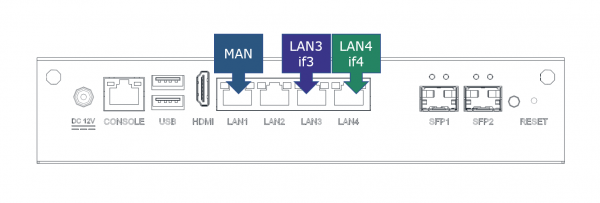NSE-X2 connections and environmental specifications: Difference between revisions
No edit summary |
No edit summary |
||
| Line 40: | Line 40: | ||
<u>TAP model (with optional inline management):</u> | <u>TAP model (with optional inline management):</u> | ||
Install the appliance between the WAN Access Device and the local switch. Connect <span style="color:#FFFFFF;"><span style="background-color:#3A3589;">LAN3</span></span> to the WAN access device and <span style="color:#FFFFFF;"><span style="background-color:#258463;">LAN4</span></span> to the local switch. | Install the appliance between the WAN Access Device and the local switch. Connect <span style="color:#FFFFFF;"><span style="background-color:#3A3589;">LAN3</span></span> to the WAN access device and <span style="color:#FFFFFF;"><span style="background-color:#258463;">LAN4</span></span> to the local switch. Doing so, <span style="color:#FFFFFF;"><span style="background-color:#3A3589;">LAN3</span></span> is facing the network and <span style="color:#FFFFFF;"><span style="background-color:#258463;">LAN4</span></span> is facing the site. | ||
''Attention 1, the appliance does not provide nor pass PoE to a powered device. You must | ''Attention 1, the appliance does not provide nor pass PoE to a powered device. You must use a power adapter or inline PoE injector to power the device.'' | ||
''Attention 2, out-of-band and inline management cannot be used together. | ''Attention 2, out-of-band and inline management cannot be used together. Devices with inline management via the connection LAN3/LAN4 enabled come with LAN1 and LAN2 disabled.'' | ||
(*) See [[NSE-11,_NSE-21_and_NSE-22_sample_configuration_Alcatel-Lucent|configuration examples for Alcatel Lucent]] | (*) See [[NSE-11,_NSE-21_and_NSE-22_sample_configuration_Alcatel-Lucent|configuration examples for Alcatel Lucent]] | ||
| Line 86: | Line 86: | ||
| | ||
| |||
=== Operating parameters === | === Operating parameters === | ||
Revision as of 17:14, 24 November 2022
Introduction
All Network Service Element come in two varieties: SPAN and TAP.
The SPAN model has two independent monitor interfaces. In a typical configuration, both ports will be connected to two SPAN output ports: one port duplicating all packets from the network to the site and the other port duplicating all packets in the opposite direction. This application offers great WAN visibility, including more precise traffic measurements than possible with flow based analysis or snmp. Other applications are possible, such as the monitoring of server traffic in a relatively small remote datacenter.
The fail-safe TAP model has been designed to be installed inline between the WAN Access Device and the local switch. No specific configuration of those devices is required.
Solution

Physical location
Make sure the ventilation holes on the left and right side of the appliace do not become obstructed so air can flow freely trough the appliance.
Network connections (appliance rear view)
This picture shows a MINIMAL SET of ports that must be connected. Connection to additional ports may be required in specific situations.
All models:
LAN1 & LAN2: to enable out-of-band MANagement, at least one of these ports must be connected to a local switchport.
SPAN model (with out-of-band management):
LAN3: MONitor port: this port must be connected to the SPAN representing the traffic FROM the network*.
LAN4: MONitor port: this port must be connected to the SPAN representing the traffic TO the network*.
TAP model (with optional inline management):
Install the appliance between the WAN Access Device and the local switch. Connect LAN3 to the WAN access device and LAN4 to the local switch. Doing so, LAN3 is facing the network and LAN4 is facing the site.
Attention 1, the appliance does not provide nor pass PoE to a powered device. You must use a power adapter or inline PoE injector to power the device.
Attention 2, out-of-band and inline management cannot be used together. Devices with inline management via the connection LAN3/LAN4 enabled come with LAN1 and LAN2 disabled.
(*) See configuration examples for Alcatel Lucent
(*) See configuration examples for Cisco
System dimensions
Width: 220mm (without mounting brackets) 430mm (with 19" mounting brachets)
Hight: 44mm
Depth: 105mm
Weight
1.0kg (without mounting brackets)
PSU specifications
PSU (Power): External power supply (IEC320 C14 connector)
Maximum heat dissipation:
Frequency: 50Hz - 60Hz
Voltage: 100V - 240V AC
Maximum current: 1.5A
Power (based on observation):
Operating parameters
Temperature: 0°C - 40°C
Humidity: 10% - 80% RH non-condensing
Maximum vibration: 0.5Grms / 5Hz ~ 500Hz
Maximum shock: 10G